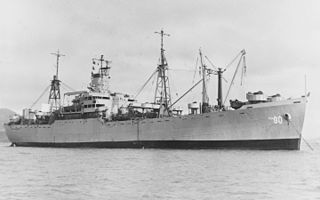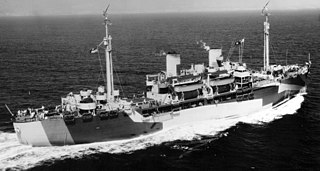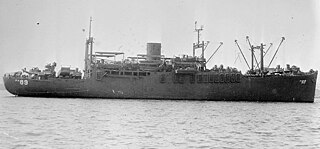Related Research Articles

USS Ottawa (AKA-101) was a Tolland-class attack cargo ship in service with the United States Navy from 1945 to 1947. She was sold into commercial service and was lost in 1951.

USS Shoshone (AKA-65) was a Tolland-class attack cargo ship of the United States Navy, named after a river in Wyoming. She was designed to carry military cargo and landing craft, and to use the latter to land weapons, supplies, and Marines on enemy shores during amphibious operations. USS Shoshone served as a commissioned ship for 21 months.

USS Whiteside (AKA-90) was an Andromeda-class attack cargo ship named after Whiteside County, Illinois. She served as a commissioned ship for 13 years and 4 months.

USS Birgit (AKA-24) was an Artemis-class attack cargo ship named after the minor planet 960 Birgit, which in turn was named after a daughter of Swedish astronomer Bror Ansgar Asplind. USS Birgit served as a commissioned ship for 16 months.

USS Virgo (AKA-20) was an Andromeda class attack cargo ship of the United States Navy, named after the constellation Virgo. She was later converted to an ammunition ship and redesignated as (AE-30). She served as a commissioned ship for 22 years and 4 months.

USS Arenac (APA-128) was a Haskell-class attack transport in service with the United States Navy from 1945 to 1946. She was scrapped in 1974.

USS Samaritan (AH-10) was a hospital ship that served with the US Navy in World War II. Prior to that, she served as a US Navy transport ship under the name USS Chaumont (AP-5).

USS Braxton (APA-138) was a Haskell-class attack transport in service with the United States Navy from 1944 to 1946. She was scrapped in 1973.

USS LST-31 was a United States Navy LST-1-class tank landing ship used exclusively in the Asiatic-Pacific Theater during World War II. Like many of her class, she was not originally named and is properly referred to by her hull designation. Later she was named for Addison County, Vermont. She was the only US Naval vessel to bear the name.
USS Chicot (AK-170) was an Alamosa-class cargo ship commissioned by the US Navy for service in World War II. She was responsible for delivering troops, goods and equipment to locations in the war zone.

USS Bowie (APA-137) was a Haskell-class attack transport in service with the United States Navy from 1944 to 1946. She was scrapped in 1973.

USS Bergen (APA-150) was a Haskell-class attack transport in service with the United States Navy from 1944 to 1946. She was scrapped in 1973.

USS Appling (APA-58) was a Gilliam-class attack transport that served with the United States Navy from 1944 to 1946. She was scrapped in 1969.

USS Colusa (APA-74) was a Gilliam-class attack transport that served with the United States Navy from 1944 to 1946. She was scrapped in 1966.

USS Frederick Funston (APA-89) was a Frederick Funston-class attack transport that served with the US Navy during World War II. Before serving as a Navy APA, she had been the US Army transport USAT Frederick Funston. After World War II, she was returned to the Army and operated as USAT Frederick Funston. Funston was among the seventy-two ships transferred to the Navy's Military Sea Transportation Service (MSTS) in the 1 March 1950 group and placed in service as USNS Frederick Funston (T-AP-178).

David C. Shanks was a troop transport that served with the US Army during World War II as USAT David C. Shanks, and during the Korean War with the US Navy's Military Sea Transportation Service as the USNS David C. Shanks (T-AP-180).

USS Nero (AC–17), a steel steam collier, was built in 1895 as the steamer Whitgift by J.L. Thompson and Sons, Sunderland, England. The vessel was purchased on 30 June 1898 from McCondray and Co. at San Francisco and commissioned on 8 June 1898.
USS Winged Arrow (AP-170) was a La Salle-class transport of the United States Navy. The La Salle class transport had a displacement of almost 14,000 long tons (14,000 t) and were designed to ferry troops and supplies to and from the war zone during World War II.

SS Sea Marlin was a C3-S-A2 cargo ship operated for the War Shipping Administration (WSA) by Grace Lines during World War II. WSA allocated Sea Marlin to United States Army requirements. Sea Marlin was crewed by United States Merchant Marines, with a contingent of the US Naval Armed Guards for the guns and had a complement of the US Army Transportation Corps aboard for troop administration.
Aloha State built by Western Pipe and Steel Company, San Francisco, as Sea Snipe for the United States Maritime Commission as a standard Type C3-S-A2 transport ship. The ship was one of the first of the standard vessels modified into a troop transport. Sea Snipe was completed 29 May 1943 and delivered to the War Shipping Administration (WSA) upon completion. American President Lines operated the ship throughout the war under a WSA agreement. The ship, after brief charter to the British Ministry of War Transport in 1946 and lay up in 1947 served as a civilian transport ship for 24 years, first as Edward Luckenbach for Luckenbach Steamship Company then Aloha State for States Marine Lines. The ship was scrapped in August 1971.
References
- 1 2 3 "Cape Newenham" (PDF). United States Department of Transportation . Retrieved 7 November 2022.
- 1 2 3 4 Charles, Roland W. (1947). Troopships of World War II (First ed.). Washington, D.C.: Army Transport Association. p. 172.
- ↑ DANFS 2016.
Online resources
- "Zeus I (ARB-4)". Dictionary of American Naval Fighting Ships . Naval History and Heritage Command. 7 March 2016. Retrieved 27 July 2017.
 This article incorporates text from this source, which is in the public domain .
This article incorporates text from this source, which is in the public domain .